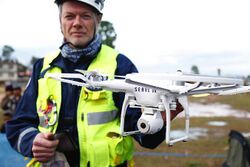Engineering:Humanitarian drone
Humanitarian dron refers to the use of unmanned aerial vehicles (UAVs) for humanitarian purposes. The term is broadly used to describe the use of drones in disaster relief, search and rescue operations, medical deliveries, and environmental protection, among other applications.
In 2010, following the earthquake that struck Haiti, drones were used for the first time in a humanitarian context to help search for survivors and assess the extent of the damage.[1] Since then, the use of drones in humanitarian settings has grown, particularly in response to natural disasters and humanitarian crises.
Applications
Humanitarian drones are increasingly being used in disaster relief efforts to help search for survivors, assess the extent of the damage, and deliver aid and supplies to affected communities.[2] In the aftermath of Hurricane Maria in Puerto Rico, drones were used to assess the damage and locate people in need of assistance.[3] In Nepal, following the 2015 earthquake, drones were used to create 3D maps of the affected areas, which helped aid organizations in their response efforts.[4] Drones are also used in search and rescue operations to help locate missing persons in difficult-to-reach areas. In 2017, drones were used in the aftermath of Hurricane Harvey in Texas to help locate people who were stranded by the flooding.[5]
Drones are also being used to deliver medical supplies and equipment to remote areas where traditional transportation methods are limited or unavailable. In Rwanda, drones are being used to deliver blood and medical supplies to rural health clinics.[6]
Challenges
One of the biggest challenges is regulatory issues, as many countries have restrictions on the use of drones. Additionally, there are concerns around privacy and data protection, as well as the potential for drones to be misused, specially in the warfare context.[7] Some other important questions about the humanitarian drones that have been address by academics, are the costs, political agendas, and ethical considerations involved in the use of drones for humanitarian purposes, and underscores the need for careful regulation and oversight of these technologies.[2]
References
- ↑ Martini, T., Lynch, M., Weaver, A., van Vuuren, T. (2016). The Humanitarian Use of Drones as an Emerging Technology for Emerging Needs. In: Custers, B. (eds) The Future of Drone Use. Information Technology and Law Series, vol 27. T.M.C. Asser Press, The Hague. doi:10.1007/978-94-6265-132-6_7
- ↑ 2.0 2.1 Bergtora Sandvik, Kristin; Lohne, Kjersti (2014). "The Rise of the Humanitarian Drone: Giving Content to an Emerging Concept". Millennium: Journal of International Studies 43 (1).
- ↑ Adams, Eric (2017). "Where Are the Drones That Could Be Saving Puerto Rico?". https://www.wired.com/story/puerto-rico-hurricane-drones/.
- ↑ McFarland, Matt. "In Nepal, a model for using drones for humanitarianism emerges". The Washington Post. https://www.washingtonpost.com/news/innovations/wp/2015/10/07/in-nepal-a-model-for-using-drones-for-humanitarianism-emerges/.
- ↑ Conner, Monroe. "NASA Commercialized Technology Assists Hurricane Harvey Recovery Efforts". https://www.nasa.gov/centers/armstrong/features/drones_assist_harvey_recovery_efforts.html.
- ↑ "Healthcare by air: Rwanda's life-saving medical drones". https://www.theguardian.com/global-development/gallery/2022/apr/20/healthcare-by-air-rwandas-life-saving-medical-drones.
- ↑ Rutger Veltman (2019). Rationalising Drone Warfare. The Biopolitics and Necropolitics of US, Israeli and UK Drone Warfare. Leiden University.
 |


